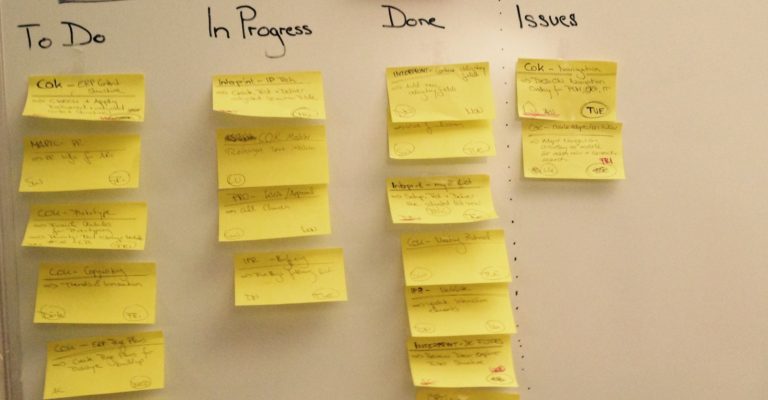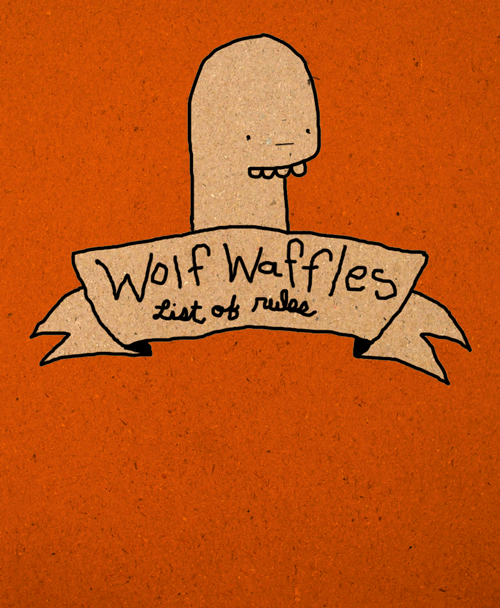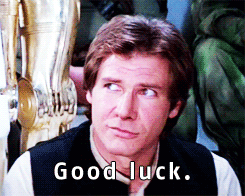
SCRUM MASTER Workshop - and what I got out of it
In September, my lovely project management colleague Laura and me participated in a SCRUM Master Certificate Workshop in Cologne. I’ve been interested in agile project management approaches for quite a while, so I was excited to get this chance and go into SCRUM a little deeper.
First big plus: Sohrab Salimi (SE-Consulting) and Reza Farhang (Crisp) were very relaxed, competent and experienced hosts, super funny also. Yeah, that’s actually important when you’re in the same room for two days. The group was a mixture of people from various backgrounds. I was surprised to find that most participants did not come from other agencies. That was actually not what I had expected - instead we found ourselves to be the only ones coming from a digital agency. Quite cool, this coincidence, we found out during the two days Workshop.
As the agency landscape is always small, cosy and familiar, you know each other, meet up in bars and so on - usually we are all a bit on the same planet, more or less. That’s cool and inspiring. But getting into deep workflow discussions with people from Mars if you are on the Moon is really refreshing to reflect what you do and how you do it.
So far so good. I’ll save the details - here is what I got out of that course, in a nutshell.
SCRUM means a big bunch of rules
In contrast to what many people „feel“ about agile methods, they mean that you follow a massive amount of rules and your plan needs to be very clear.
Yeah, most of us knew that already. But what if you are not that kind of company, making decisions two years in advance, following a strict plan all day long, every day? What if you are more like a creative playground? And if that’s exactly the plan? Rules are cool. Actually i love rules. To me they are key to make things easier. So, by nature, I’m in a field of tension between creative work and the inner need for structure. By choice actually. But you don’t go to a workshop to learn stuff by heart, right?

Nice to notice that SCRUM is what you make it. If you have a smart, creative team and you are the structure nerd in that group, focus on keeping them focused. You are the dude holding up the umbrella on this sightseeing tour. As long as everyone gets the great idea, you’re on a good way. You follow a common goal, that’s what it’s all about. Now you only need to channel this energy.
Make it a team
If you’re in an agency, too, you possibly work on more than one project at a time. In general not a problem, we are used to that kind of multi-tasking, as long as your team is on the same train it’s all good. But what if your team is not?

What if your team changes with every client, every project, maybe even within a project? Yes, you will get somewhere. But this is what causes a lot of on-boarding and off-boarding overhead. Every new team constitution means, new people have to understand each other and share a big picture - again. Sounds exhausting? It is.
So: working agile really makes most sense in a stable team. Yes, we tried it and, yes, we love it. We changed our agency structures some months ago to channel that energy and call our teams the „squads“. The icing on the cake: When every team begins to develop a common identity and goals that are different from other teams’ ideas. This is where the fun starts.
Make agreements
No really - make agreements. Don’t just say so, do so. Note them down, visible for everyone, and follow up on them. As each team has it’s own shape and sphere, begin with what you may think is „clear anyways“. And you will remember quickly that actually nothing is „clear anyways“.

Start with asking everyone in your team about his certain role. Stuff like: What is a standard set of information you need to start with a piece of your work? And: What does it mean when you say „I am done“? As soon as you have figured those two basic aspects for every role in your team, you surely know many other painpoints that need to be clarified. Once you’ve gone through this, it will be a great benefit for your team, it will increase understanding for each other and bring project you approach to another level. The steps in between then just become a matter of workflow and good organization.
How you make agreements
Not everyone in your team is super outgoing and straight forward outspoken? You’re lucky. Imagine a uniformed bunch of born leaders. Hard to get along with, right?

Some people are heard easier than others. Because they’re louder, faster, bigger… you name it. That’s cool, qualities vary. A super simple way to give everyone the same voice: Make „Fist of Five“-decisions when it’s really important. It may feel awkward at first, but it works. Use your hands to show how much you really agree to something on a scale from zero to five. Five is all in, zero is all out. You get it, right?
This workflow thing…
Yeah, right - there was something. „The steps in between just become a matter of workflow and good organization.“ But how do you do that?
This will always be individual. Not just for each team, but it also depends on the project and what it’s all about. Do you really need the strict sprint planning that SCRUM applies? For every project? Not sure. And where it get’s tricky: You possibly work on more than one project at a time. This is not exactly what SCRUM has in mind. This might be a moment you need to get off the SCRUM path, if it works better.
Instead, get creative. Sometimes it’s hard to find out what works for the team. But let’s be realistic: that’s the job. No one else will do this for you. There is no recipe for „the perfect“ workflow. And actually - isn’t this the cool thing about this job?
You love tickets? Try tickets. You are best with emails? Send emails. You read Excel sheets like others’ do Marvel Comics? Go for it. You’re into Post-Its? Maybe a good idea to use them. Just one thing you shouldn’t forget: Whatever tool you use - it won’t talk to those guys in your team in your place.

For us, a hybrid strategy helps to keep track of what’s going on. We love tickets to organize and document our work, so we always know who needs to move. But a weekly offline Post-It-SCRUM board makes it easy to see what’s on our desks. And: it’s a strong conversation accelerator.
That’s today - but to be honest: were evolving. And so do our workflow Tools.
In the end…
A quick glance says: well, heard that before. Yes - but the workshop really started some discussion in the team. It helped to reflect how I approach projects, and how others do. We are all a little different, but the same in the end. Why SCRUM then, at all?
The coolest thing about SCRUM is, it’s all about learning stuff. You cannot apply structures to someone and expect that person to grow. SCRUM is about finding something.
Find out how this new tool works. Find a way to structure this mess. Find the solution for that tricky requirement. Find a design element that feels really delightful. Find a way to communicate what’s on your mind. Find a shared vision for this cool thing you work on. Find out where to impove. Just go on with this list.
Sounds like a playground? Right, sounds like us :)


